OLED is an emerging display and lighting technology that enables beautiful and efficient displays and lighting panels. Thin OLEDs are already being used in many mobile devices and TVs. Polymer-OLEDs (or PLEDs, also used to be called P-OLEDs) are OLED devices made from polymer (large-molecules) materials.
PLEDs vs SM-OLEDs
Basically you can make OLEDs from two kinds of materials: small-molecule (SM-OLED) or large-molecules, or polymers. Virtually all OLED displays on the market toady are using Small Molecules, and are produced using evaporation processes.
PLED (P-OLED) materials do not perform as good as SM-OLEDs in terms of lifetime and efficiency, but are easily soluble and so can be easily adapted for printing and other solution-based processes. In the past some believed that the soluble nature of PLEDs mean that these materials will be the future of OLED displays, but that has not been the case yet. There has been great progress in evaporation processes and materials - and also in soluble SM-OLEDs.
CDT / Sumitomo
UK-based Cambridge Display Technology (CDT) is the company that holds the basic patents for PLED technologies. The company licensed its technology to several companies, including Philips, Seiko Epson, Osram, Dupont and Delta Optoelectronics, but it does not seem as it anyone is pursuing PLEDs at the moment besides Sumitomo Chemicals (which owns CDT).
Sumitomo and CDT are still developing PLED materials and panels. Sumitomo is providing emitter materials for JOLED (who started low volume production of printed OLED monitor panels in December 2017, see below) and is hopefully gearing up to start mass production of its own OLED lighting panels.
JOLED's PLED
JOLED (Japan OLED) was established in August 2014 by Japan Display, Sony and Panasonic with an aim to become an OLED medium display (10-30 inch) producer, mostly targeting monitors and commercial applications. JOLED is using a printing process which should result in lower cost production (but of lower performance displays) compared to evaporation printing.
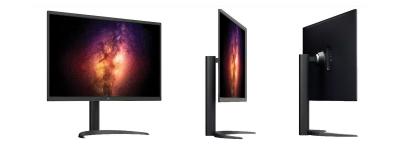
JOLED is using PLED materials produced by Sumitomo (see above). The company started commercial low-volume production of its 21.6" 4K OLED panels towards the end of 2017 at the company's pilot 4.5-Gen line. In 2021 JOLED started mass producing PLED displays at its 5.5-Gen line in Nomi City.
Panasonic's 2013 56" OLED TV prototypes
In January 2013 Panasonic unveiled a 56" 4K (3840x2160) OLED TV panel prototype that was produced using an all-printing method and PLED materials. Panasonic says that all the organic materials were deposited using ink-jet printing. The panel's TFT substrate was supplied by Sony (and actually made by AUO. It's an Oxide-TFT panel) as part of the two companies collaboration. The lifetime and efficiency of this TV was not disclosed.
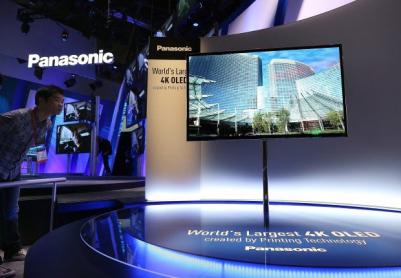
In December 2013 Sony and Panasonic announced that they are canceling the OLED TV JV. Panasonic is now producing OLED TVs - but these use WRGB OLED panels produced by LG Display.
P-OLED (PLED) vs pOLED
P-OLEDs, or PLEDs, are a class of OLED materials. Somewhat confusingly, LG Display is branding its mobile flexible AMOLED displays as pOLEDs (plastic OLEDs). For more information on LGD's pOLEDs, click here.
Further reading
The latest PLED news:
Panasonic re-organizes to put more focus on OLED displays
According to a report from Nihon Keizai, Panasonic has taken steps to streamline its R&D and put more focus on OLED TV development. The company plans to invest ¥30 billion ($385 million) in a pilot AMOLED production line in Himeji (this was already reported in April). According to the report Panasonic wants to use PLEDs and ink-jet printing in its upcoming fab. Panasonic's P-OLED/Ink-jet development dates back to the OLED TV joint-venture with Sumitomo in 2009.
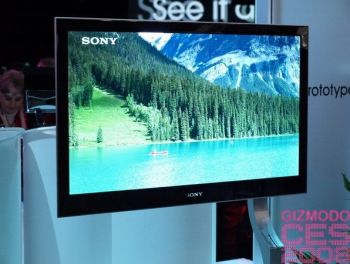 Sony OLED TV prototype
Sony OLED TV prototype
The report also details the collaboration between Panasonic and Sony. The two companies have quite different technologies - Panasonic with its P-OLED and printing processes and Sony with small-molecules and VTE. It is claimed that Sony will mostly supply capital for Panasonic, and not technology. Sony's own OLED technology will be used though by Japan Display to make small sized panels.
Introduction to LECs, a cheaper and flexible alternative to OLEDs
One of the promises of OLED lighting is that flexible panels can be produced on the cheap using roll-to-roll processes. There is a lot of work towards this goal, but it hasn't been achieved yet. Now researchers from Sweden and Denmark have managed to produce light-emitting electrochemical cells (LEC) using an all-solution-based R2R fabrication process, in ambient conditions. They say that this process can be used to create large area panels too.
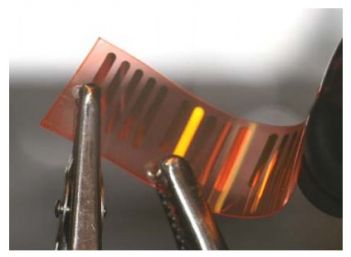
Polymer LEC panels are similar to PLEDs in structure, but in LECs the emitter polymer is blended with an electrolyte (e.g. LiCF3SO3 dissolved in PEO). LECs, which require only three layers, were first reported 15 years ago, but they suffered from very low lifetime and efficiency. But LECs are very easy to produce and so with steady improvements (mostly from choice of electrodes) LECs are now ready to enter the lighting market.
On Sumitomo's OLED lighting program
Last week we reported that Sumitomo Chemical is planning to start mass producing OLED lighting panels later in 2012 based on their PLED technology in a ¥5-6 billion ($60-70 million) investement. Now Sumitomo finally announced that they plan to unveil panels at the L+B 2012 exhibition, and also unveiled a web page with lot's of info on their PLED lighting program. It seems that the company will commercial PLED panels for "decorative lighting" in 2013, and for general lighting in 2015.
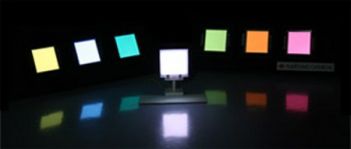
In L+B2012 Sumitomo will show new PLED panels that are about 10 centimeters square each. There will be panels in sixty different colors, which are made using printing technology (all layers except the electrodes). The booth was designed by world-renowned Japanese lighting designer Motoko Ishii, with the theme The Colors of Japan The Colors of Harmony, in an innovative attempt to replicateâby means of lightingâthe elegant and refined colors of ancient Japan in a modern day setting of a Japanese traditional tearoom. Here's what the booth will look like:
Sumitomo Chemical to start producing OLED lighting panels?
Update: Here's some official notice from Sumitomo on their PLED lighting plans...
There are reports that Sumitomo Chemical is planning to start mass producing OLED lighting panels. The company will start accepting orders next month, with mass production to begin later this year. Sumitomo will invest ¥5-6 billion ($60-70 million) in equipment.
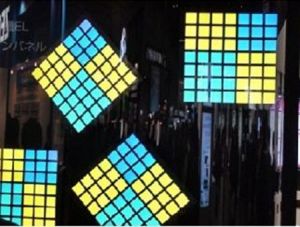
Sumitomo will probably base their lighting panels on PLED materials. If indeed this report is true we'll probably hear something official soon.
Panasonic is building an 8.5-Gen OLED TV pilot production plant
According to new reports, Panasonic started to build a new 8.5-Gen OLED TV pilot production plant in Himeji, Japan. The company has already ordered some of the equipment. Panasonic's Himeji plant is currently producing LCDs (apparently it has a capacity of 810,000 monthly TVs).
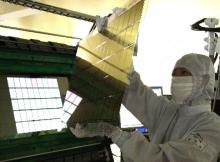
Reportedly, the investment in this stage will not be large as this will be a small pilot line - Panasonic currently only wants to do some R&D and testing there. The company still needs to assess the business model. But its clear that the Japanese maker does not want to leave the emerging OLED TV business to its Korean competitors...
Analyst: Apple and Sharp to jointly develop iPhone and iPad OLED panels within 1-2 years
Peter Misek, an analyst at Jefferies says that he believes that Apple decided to buy iPad 3, iPhone 5 and TV display panels from Sharp. At first these will be IGZO based LCDs - which will be brighter, clearer, thinner and more efficient than existing LCDs. But Misek also believes that Sharp and Apple will jointly develop OLED displays (probably IGZO based as well) within 1-2 years which will be used in future iPhone and iPad generations. OLED TV panels aren't expected until 2015.

Misek says that the two companies are working towards a new printing technology for producing these small/medium OLED panels - and that a pilot line will be in place by middle 2012 for testing purposes. Full production will be possible in 2013. The new technology, according to Misek, is a combination of inkjet printing and a daisy wheel. The daisy wheel is an impact printing technology and I'm not sure how it relates to OLEDs.
More details about Sumitomo's upcoming PLED material factory
A few weeks ago we reported that Sumitomo Chemical began construction of a PLED material factory (which will be operational in 2012) in a several billion yen investment. These materials are aimed towards large panel (OLED TV) production. Today we have a new report that say that Sumitomo made a breakthrough in its PLED material technology - which will eventually enable production cost to be slashed by up to 50% (compared to SM-OLED based displays).
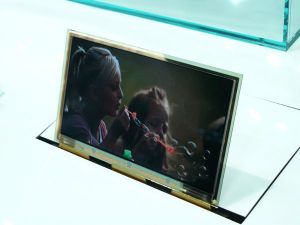 Sumitomo 6.5-inch AMOLED prototype
Sumitomo 6.5-inch AMOLED prototype
The annual output of their new Osaka plant will be enough to produce 4-5 million 40" OLED TVs. Sumitomo plans to offer these materials to TV makers in Japan, South Korea, and Taiwan. PLEDs (or Polymer-OLEDs, sometimes called PLED too) are OLED devices made from polymer (large-molecules) materials and are more easily adapted for printing (solution-processable) compared to Small-Molecule OLEDS (SM-OLEDs). Some companies believe that PLEDs are the best way to create large OLED panels using printing methods. You can read more about PLEDs here.
Sumitomo to start producing high-performance P-OLED materials for OLED TVs in 2012
Update: we have some more information about this upcoming plant, read more here
Sumitomo Chemical have began construction of a PLED material factory in Osaka, Japan. The company says that this plant will start mass-production of high-performance P-OLED materials in 2012. Total investment will be a several billion yen (a billion yen is about $12 million).
 Sumitomo 6.5-inch AMOLED prototype
Sumitomo 6.5-inch AMOLED prototype
According to the report, these materials will be used for OLED TV production. Interestingly, back in 2009 Sumitomo said that 2012 will be the year when OLED TV finally takes off...
CDT and Singapore's NUS signed a five-year IP licensing pipeline agreement
 Cambridge Display (CDT) and the National University of Singapore (NUS) Organic Nano Device Laboratory (ONDL) signed a five year intellectual property (IP) pipeline licensing agreement to commercialize the innovations arising from NUS's polymer-OLED (PLED) research.
Cambridge Display (CDT) and the National University of Singapore (NUS) Organic Nano Device Laboratory (ONDL) signed a five year intellectual property (IP) pipeline licensing agreement to commercialize the innovations arising from NUS's polymer-OLED (PLED) research.
Under the terms of this agreement, CDT will be able to access new innovations from ONDL research and take licenses in existing and new IPs in PLED displays and lighting, solar cells and thin film transistor circuits. CDT will pay royalties to the NUS if/when they commercialize these activities.
Interview with Andy Hannah, Plextronics' CEO
 Back in 2006, we published an interview with Andy Hannah, Plextronics' president, CEO and co-founder. Andy agreed to do a follow-up interview to update us on Plextronics' business and technology.
Back in 2006, we published an interview with Andy Hannah, Plextronics' president, CEO and co-founder. Andy agreed to do a follow-up interview to update us on Plextronics' business and technology.
Plextronics is a US-based company (established in 2002, as a spin-out from Carnegie Mellon University) that is developing technology that enables broad market commercialization of organic electronic devices - including OLEDs, plastic chips, polymer solar cells and organic sensors.
Q: Andy, can you give us a short introduction to your OLED technology?
Q: The benefits of OLEDs include, of course, being printable, low cost and demonstrating enhanced device performance. Plextronics’ technology plays a key part in achieving these benefits by reducing operating voltage in devices and thereby increasing lifetime and power efficiency.
Pagination
- Previous page
- Page 6
- Next page



